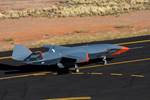Boeing Australia advances flight testing of Loyal Wingman
Two separate Loyal Wingman aircraft completed successful flight missions to aid in the continuation of improving the unmanned vehicle’s development.

Two Loyal Wingman aircraft successfully completed separate flight missions. Photo Credit: Department of Defense, Boeing Australia
Boeing Australia has expanded its flight-test program of the Boeing Airpower Teaming System — also known as the Loyal Wingman project — with recently successful, separate flight missions of two of the composites-intensive unmanned aerial vehicle aircraft at the Woomera Range Complex, an Australian military and civil aerospace facility.
The first Loyal Wingman aircraft developed with the Royal Australian Air Force (RAAF) demonstrated a range of key characteristics during the test flights to continue to expand the flight envelope. A second aircraft also successfully completed its first flight mission.
“It is so exciting seeing two aircraft in the air as the Loyal Wingman continues to excel in the flight-test program,” says Air Vice-Marshal (AVM) Cath Roberts, RAAF head of air force capability. “This opens up significant capability agility for Air Force, particularly with features such as the reconfigurable nose. We’re heavily engaged in the payload development and the element of surprise that it gives us in the battlespace.”
Throughout the flight-test missions, the teams gathered aircraft performance data that will be used to inform and refine the digital twin of the Loyal Wingman, with the view to accelerate the aircraft’s development where possible. The digital twin models the system’s entire lifecycle, from design and development to production and sustainment, and contributes to speed and first-time quality.
“We’re in a steady rhythm of flight testing on the way to mission and operational testing, enabling Boeing Australia, RAAF and our Australian industry team of more than 35 companies to progressively advance the flight characteristics and capabilities of the uncrewed teaming system,” says Glen Ferguson, director of Boeing Airpower Teaming System – Australia and International. “I’d like to extend my thanks to our capability partner BAE Systems Australia, and to RUAG Australia for their specific roles in this latest test block.”
The flight tests of the first aircraft one included the first time the landing gear was raised and engaged. RUAG Australia (Wingfield SA) supplied the landing gear systems to the aircraft, and BAE Systems Australia (Edinburgh) was integral in the design, supply and support of the flight control and navigation systems tested as part of the flights.
According to partners, the first batch of Loyal Wingman aircraft are serving as the foundation for the Loyal Wingman project being developed for various global defense customers. The aircraft will fly alongside other platforms, using artificial intelligence to team with existing crewed and uncrewed assets to complement mission capabilities.
Related Content
-
Pull-wound carbon fiber poles enable lightweight, compact, rigid emergency stretcher
Based on military feedback, Epsilon Composite developed an optimized, foldable stretcher that combines telescopic pull-wound carbon fiber tubes.
-
LifePort acquires Aeromatrix Composites advanced materials line
The aircraft manufacturer solidifies its capability to provide next-generation advanced materials solutions to aerospace and defense customers.
-
Hypersonix receives CMC scramjet manufacturing demonstrator
HTCMC component demonstrates manufacturing of future Spartan scramjet engine required for reusable hypersonic vehicles capable of up to Mach 12 flight.















.jpg;maxWidth=300;quality=90)
